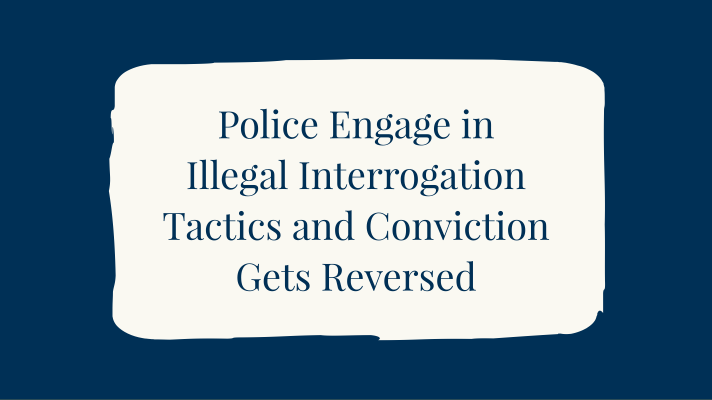
Apparently, the answer is “Yes.”
There’s an excellent article in NPR from journalist Meg Anderson saying that advocates are pushing for laws that effectively ban police from lying to suspects during interrogations. In every state, police officers are allowed to lie to adults during an interrogation. The hope, in many cases, is that they’ll get a person to confess to committing a crime.
BACKGROUND
When it comes to laws enforced by the justice system, we have an expectation of honesty, integrity, and transparency. However, police officers are legally empowered to use deception and other types of lies during interrogations.
This ability originates from the 1969 Supreme Court case Frazier v. Cupp, which ruled specific police lies were permissible. The case involved officers falsely telling the suspect that his associate had already confessed, leading the suspect to also confess. The Court said this lie alone was not enough to make the confession involuntary or violate his Constitutional rights.
Since then, no laws have established clear boundaries around what interrogation lies are appropriate versus unethical. Generally, police are legally empowered to:
- Verbally make false statements about evidence
- Momentarily lie about offense seriousness or punishment
- Make unfulfillable promises of leniency for waiving rights
- Lie about what others told them or what evidence reveals
- Threaten charges against or harsher punishment for family members
Defense lawyers and civil rights advocates have raised increasing concerns about the prevalence of deception. The argument is that lying puts innocent people at risk of false confessions. However, prominent judges have argued that only coerced confessions through abuse or misconduct can be thrown out – not those involving lies alone. The ethics remain hotly debated.
“Police are trained around the country in all 50 states to use deception during interrogation, to lie both about the evidence against a suspect and to lie about the consequences of confessing in order to make it seem not so bad if you just say that you did these things.” ~Attorney Laura Niridier
Unfortunately, deceptive tactics can also draw false confessions. According to the Innocence Project, nearly a third of DNA exonerations from 1989 to 2020 involved a false confession. Legal experts say the deception bans passed in recent years fail to protect other vulnerable groups: young adults, people with intellectual disabilities, even just people who are naturally compliant.
A GROWING NUMBER OF STATES ARE PASSING LAWS THAT STOP DECEPTIVE TACTICS AT POLICE INTERROGATIONS
Ten states have passed laws in recent years effectively banning police from lying to juveniles during interrogations, starting with Illinois in 2021. And some legal advocates are pushing for a deception ban that would apply to everyone, not just kids. Deception is a powerful law enforcement tool in eliciting confessions, says wrongful convictions attorney Laura Nirider.
WASHINGTON PROPOSED LEGISLATION TO STOP DECEPTIVE INTERROGATIONS
In Washington state, Democratic lawmakers want to set a higher bar: A bill that would make incriminating statements made in police custody – by adults or children – largely inadmissible in court if obtained using deception. State Rep. Strom Peterson has introduced the bill twice. However, the legislation hasn’t gone anywhere.
The Washington Association of Sheriffs and Police Chiefs said in a statement that it opposes such a measure, because banning deception would take away a tactic that yields “many more true confessions” than false ones.
“Criminals often conduct elaborate stories to conceal their crimes . . . Sometimes the use of deception is required to locate the truth both to convict and to exonerate people. Such deceptions include telling a person that abuse was discovered during a routine medical exam rather than reported by a family member.” ~James McMahan, Director of the Washington Association of Sheriffs and Police Chiefs
GIVING POLICE NEW TOOLS
Those against deception bans see them as an attack on police, says Mark Fallon, a consultant on interrogation practices and former federal agent. In fact, he says, it’s the opposite. There’s another way for police to question people, Fallon says, that relies on building rapport and asking open-ended questions, and where the primary goal is information, rather than a confession.
That technique is used in other countries, including much of Europe. In England, France, Germany, Australia, Japan and elsewhere, for instance, the police are generally not allowed to deceive suspects.
My opinion? Honestly, I’ve never seen a circumstance where a police officer intentionally lied or deceived a suspect during an interrogation in order to illicit a confession. I simply don’t see this technique happening in the police agencies I work with.
Nevertheless, it appears other law enforcement agencies outside of Whatcom and Skagit County use this questionable technique. Clearly, the problem with deceptive interrogation techniques is that it creates more deception. If discovered, the defendant’s confession is clearly corrupted by the lies used to bring it. Studies show that telling little fibs leads down a slippery slope to bigger lies. Our brains adapt to escalating dishonesty, which makes deceit easier. In those cases, a Motion to Suppress the corrupted/false interrogation may be appropriate.
Please contact my office if you, a friend or family member are charged with a crime. Hiring an effective and competent defense attorney is the first and best step toward justice.














